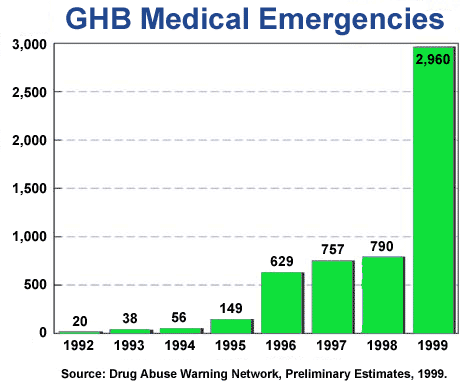We don't yet know if GHB abuse is a fad or if it will become an epidemic, but the knowledge exchanged at this conference will keep NIDA on top of the problem," said Dr. Jerry Frankenheim of NIDA's Division of Neuroscience and Behavioral Research (DNBR). Dr. Frankenheim served as chair of the day-long "All About GHB" conference held last summer. NIDA sponsored the meeting to share expert information about gamma-hydroxybutyrate (GHB), an increasingly abused, potentially lethal illegal drug.
Nearly 50 participants from around the world heard accounts of GHB distribution and acquisition, trends in GHB abuse, and information on the symptoms and treatment of GHB overdose. Participants discussed the basic science of GHB, including its biochemistry, behavioral neuropharmacology and toxicology, pharmacokinetics, physiological functions, and the potential medical uses of GHB. "This is the first time that epidemiologists, physicians, basic researchers, and representatives of law enforcement have met on the topics of GHB and the chemicals that can be converted to GHB by the ," said Dr. Minda Lynch of DNBR, a meeting co-chair.
 The number of patients treated for GHB overdose or GHB-related problems in hospital emergency departments has increased sharply in the last 5 years.
The number of patients treated for GHB overdose or GHB-related problems in hospital emergency departments has increased sharply in the last 5 years.GHB is a central nervous system (CNS) depressant and is most often abused in an attempt to feel euphoric, relaxed, and uninhibited. In the United States, GHB can be prescribed in a very low dose as an experimental treatment for narcolepsy, a sleep disorder, under tightly controlled conditions. However, those who abuse GHB (also known as "G" or "liquid ecstasy") may require emergency medical attention when they overdose or experience withdrawal symptoms.
Dr. Frankenheim said that few data are available yet on the relatively new problem of GHB abuse-the Government has tracked GHB use only since it was declared illegal in March 2000. GHB abuse is also difficult to monitor because the drug can be easily manufactured with recipes available on the Internet. Further, there is no simple diagnostic test for GHB that can be used in hospital emergency departments, so it often goes undetected.
GHB overdose can cause unconsciousness, slowed heart rate, respiratory depression, seizures, hypothermia, nausea, vomiting, and coma. The combination of coma and vomiting or coma and a blocked airway can be deadly. "GHB has several characteristics that increase the likelihood of toxicity," says Dr. Frankenheim. "A small increase in dose can push the sedative effects to a lethal level. High doses of GHB overwhelm the 's ability to eliminate the drug, and therefore lead to greater effects of longer duration than expected." GHB's purity and strength are especially difficult to determine because the drug can be made from a number of chemical formulas, which differ in the amount of GHB produced when metabolized by the user's .
When GHB is ingested with other drugs, especially alcohol and other CNS depressants, its potential for deadly effects increases. GHB, usually in combination with alcohol, has been linked to more than 60 deaths, almost 60 percent of which were among people aged 20 to 29. The number of reported GHB-related deaths probably underestimates the true number, since GHB does not remain in the very long and is usually not tested for at autopsy. In response to recent GHB-related emergencies as public health concerns, the Institute has issued a request for grant proposals to study GHB and its precursors. Through its GHB Antidote Initiative, NIDA is beginning the process of developing an antidote for GHB poisoning.
GHB and other club drugs are often abused by young people at all-night parties and "raves," but evidence indicates that GHB abuse is spreading beyond the club scene. For example, builders have said they use GHB because it stimulates the release of growth hormone. Alcoholics may take GHB in an attempt to eliminate alcohol cravings, in spite of a lack of medical approval for this use in the United States. In some European countries, GHB is prescribed as a treatment for alcoholism.
The meeting also highlighted the criminal practice of covertly slipping GHB into a person's drink to make that person more susceptible to sexual assault. GHB and a similar drug, Rohypnol, are known as "date rape" drugs. Robert P. Mecir of the Bureau of Narcotic Enforcement Regional Office in San Jose, California, said that substances used for "drug rape"-a more accurate term than "date rape"-can render the victim helpless by causing a loss of muscle coordination, confusion, sedation, and amnesia.
The addictive potential of GHB is not yet known, but individuals who use GHB report that they must increase dosage to continue to attain euphoric and relaxing effects. Dr. Karen Miotto of the University of California, Los Angeles, described the severe withdrawal symptoms-extreme agitation, delirium, insomnia, tremor, rapid heart rate, and anxiety-experienced when chronic GHB use is discontinued. Some people who abuse GHB have difficulty reducing or discontinuing use.
"The public may mistakenly perceive GHB as a safe drug because it was only recently made illegal, was previously available in health food stores as a dietary supplement, is marketed over the Internet, and is prescribed for limited medical use," Dr. Frankenheim says. To combat this misconception, NIDA is providing science-based information about GHB and other club drugs to teens, young adults, parents, and communities. NIDA recently disseminated a special Community Drug Alert Bulletin and continues its efforts to educate the public about the dangers of club drugs. (See "NIDA Launched Initiative to Combat Club Drugs" and "A Club Drug Alert")